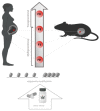Epigenetic Studies for Evaluation of NPS Toxicity: Focus on Synthetic Cannabinoids and Cathinones
- PMID: 35740419
- PMCID: PMC9219842
- DOI: 10.3390/biomedicines10061398
Epigenetic Studies for Evaluation of NPS Toxicity: Focus on Synthetic Cannabinoids and Cathinones
Abstract
In the recent decade, numerous new psychoactive substances (NPSs) have been added to the illicit drug market. These are synthetized to mimic the effects of classic drugs of abuse (i.e., cannabis, cocaine, etc.), with the purpose of bypassing substance legislations and increasing the pharmacotoxicological effects. To date, research into the acute pharmacological effects of new NPSs is ongoing and necessary in order to provide an appropriate contribution to public health. In fact, multiple examples of NPS-related acute intoxication and mortality have been recorded in the literature. Accordingly, several in vitro and in vivo studies have investigated the pharmacotoxicological profiles of these compounds, revealing that they can cause adverse effects involving various organ systems (i.e., cardiovascular, respiratory effects) and highlighting their potential increased consumption risks. In this sense, NPSs should be regarded as a complex issue that requires continuous monitoring. Moreover, knowledge of long-term NPS effects is lacking. Because genetic and environmental variables may impact NPS responses, epigenetics may aid in understanding the processes behind the harmful events induced by long-term NPS usage. Taken together, "pharmacoepigenomics" may provide a new field of combined study on genetic differences and epigenetic changes in drug reactions that might be predictive in forensic implications.
Keywords: forensic science; new psychoactive substances; pharmacoepigenomics.
Conflict of interest statement
The authors declare no conflict of interest.
Figures


Similar articles
-
Synthetic Cannabinoids and Cathinones Cardiotoxicity: Facts and Perspectives.Curr Neuropharmacol. 2021;19(11):2038-2048. doi: 10.2174/1570159X19666210412101929. Curr Neuropharmacol. 2021. PMID: 33845747 Free PMC article.
-
The Toxicology of New Psychoactive Substances: Synthetic Cathinones and Phenylethylamines.Ther Drug Monit. 2016 Apr;38(2):190-216. doi: 10.1097/FTD.0000000000000263. Ther Drug Monit. 2016. PMID: 26587869 Review.
-
Next generation of novel psychoactive substances on the horizon - A complex problem to face.Drug Alcohol Depend. 2015 Dec 1;157:1-17. doi: 10.1016/j.drugalcdep.2015.09.030. Epub 2015 Oct 9. Drug Alcohol Depend. 2015. PMID: 26482089 Review.
-
Toxicological Analysis of Illicit Drugs Seized in Naples (Italy) and First Detection of Synthetic Cannabinoids during COVID-19 Pandemic.Healthcare (Basel). 2022 Aug 8;10(8):1488. doi: 10.3390/healthcare10081488. Healthcare (Basel). 2022. PMID: 36011145 Free PMC article.
-
New Psychoactive Substances and receding COVID-19 pandemic: really going back to "normal"?Acta Biomed. 2022 May 11;93(2):e2022186. doi: 10.23750/abm.v93i2.13008. Acta Biomed. 2022. PMID: 35545997 Free PMC article.
Cited by
-
Modern perspectives on psychoses: dissociation, automatism, and temporality across exogenous and endogenous dimensions.Front Psychiatry. 2025 Mar 20;16:1543673. doi: 10.3389/fpsyt.2025.1543673. eCollection 2025. Front Psychiatry. 2025. PMID: 40182206 Free PMC article. Review.
-
Mutuality of epigenetic and nanoparticles: two sides of a coin.Heliyon. 2023 Dec 13;10(1):e23679. doi: 10.1016/j.heliyon.2023.e23679. eCollection 2024 Jan 15. Heliyon. 2023. PMID: 38187314 Free PMC article. Review.
-
Rethinking Mental Automatism: De Clérambault's Theory in the Age of Novel Psychoactive Drugs: Psychotropic Effects and Synthetic Psychosis.Healthcare (Basel). 2024 Jun 10;12(12):1172. doi: 10.3390/healthcare12121172. Healthcare (Basel). 2024. PMID: 38921287 Free PMC article.
-
Geospatiotemporal and Causal Inferential Study of European Epidemiological Patterns of Cannabis- and Substance-Related Congenital Orofacial Anomalies.J Xenobiot. 2023 Feb 1;13(1):42-74. doi: 10.3390/jox13010006. J Xenobiot. 2023. PMID: 36810431 Free PMC article.
References
-
- Roman-Urrestarazu A., Robertson R., Yang J. European Monitoring Centre for Drugs and Drug Addiction, European drug report 2018: Trends and developments. Bmj. 2018;362 - PubMed
-
- EMCDDA European Monitoring Centre for Drugs and Drug Addiction . European Drug Report 2020: Trends and Devel-Opments. Publications Office of the European Union; Lisbon, Portugal: 2020.
-
- United Nations Office on Drugs and Labor . World Drug Report 2020. United Nations; Vienna, Austria: 2021.
Publication types
LinkOut - more resources
Full Text Sources

